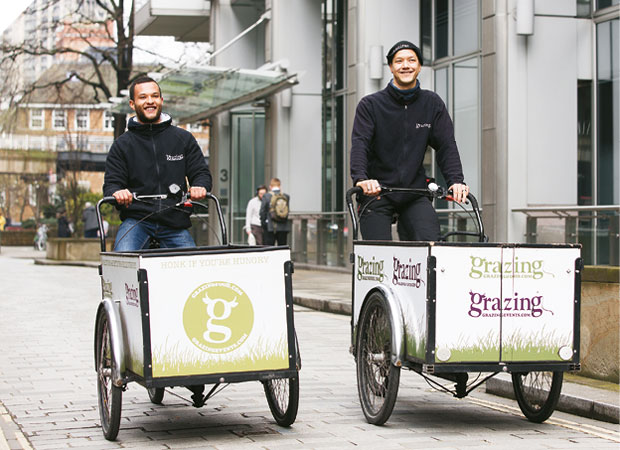 Sam Hurst, Founder and CEO of the delivered-in office and venue catering specialist Grazing explains why it’s been lauded as a flexible, cost-effective and sustainable provider for many modern workplaces
Sam Hurst, Founder and CEO of the delivered-in office and venue catering specialist Grazing explains why it’s been lauded as a flexible, cost-effective and sustainable provider for many modern workplaces
Q: Grazing’s office catering solution via an offsite production delivery model was a major disruptor to the conventional workplace catering model – what prompted you to launch the idea?
A: It was actually demand-led – nearly 12 years ago, a client in the City asked us if we could cook food in our kitchen and deliver it into their offices and serve it there, and we said yes. It took a bit of time to figure out how to do it, but having done it for well over a decade now, we have it down to a fine art.
Q: What are the main advantages of this approach e.g. less waste, cost, sustainability?
A: The main advantage is flexibility. It suits a new way of working where people do not necessarily use the workplace five days a week anymore. They might only use it three or four days a week, sometimes less than that, and our model allows the employer to flex their catering in line with their office occupancy.
So, if they’re very busy Tuesday, Wednesday and Thursday, they can have catering on those days at the level they need it. If they don’t have many people in the office on a Friday, they don’t need to be paying for services and staff they don’t need. There are great efficiencies and benefits in terms of waste, cost and sustainability.
Q: How does the Grazing model work in practice, particularly at the onsite service end?
A: It’s very simple; we have decoupled front and back of house. Back of house is taken care of at our kitchen hub in Bermondsey, while to oversee the front of house, we might have a general manager, a hospitality manager and general assistants based at client sites – our teams vary in size.
 Our smallest office-based team is just three people and our largest is about 10, and they predominantly take care of all the front of house functions you would typically expect from any contract catering service. Depending on the facilities at each client site, we may also have a chef or small kitchen team to do basic prep and/or regen onsite but with most of the cooking being done at our Central Production Unit (CPU), our sites are generally looked after by our front of house team. The only difference between our model and the traditional contract catering model is that the food has not come through the swing door of a kitchen on the premises, it’s come from a kitchen across London. Our team receive the food in thermal boxes and set it out in serveries, meeting rooms or hospitality spaces.
Our smallest office-based team is just three people and our largest is about 10, and they predominantly take care of all the front of house functions you would typically expect from any contract catering service. Depending on the facilities at each client site, we may also have a chef or small kitchen team to do basic prep and/or regen onsite but with most of the cooking being done at our Central Production Unit (CPU), our sites are generally looked after by our front of house team. The only difference between our model and the traditional contract catering model is that the food has not come through the swing door of a kitchen on the premises, it’s come from a kitchen across London. Our team receive the food in thermal boxes and set it out in serveries, meeting rooms or hospitality spaces.
Q: The majority of your deliveries are via cargo bike – can clients use this to meet their Scope 3 emission targets?
A: Yes, I believe they can. And it’s not just about delivering once or twice per site per day via cargo bikes, which are an efficient and low emissions delivery option with a payload of about 200 kilos – not dissimilar to a small van. The fact we work out of a CPU also means we’re reducing our emissions.
A traditional contract catering kitchen within an office building might have five or six supplier deliveries per day –perhaps from a butcher, a baker, the greengrocer, their dairy supplier, and their dry goods supplier, all of which are traditionally delivered by vans. We’ve taken all those vans off the road because those deliveries are coming into one place – our kitchen hub – and then going back out via cargo bike.
So, for every site we have, we’re probably taking somewhere in the region of six or seven van deliveries off the road each day. Sometimes it’s even more than that. So yes, it does count towards your Scope 3 emission targets in quite a significant way.
Q: Grazing’s approach pre-dated hybrid working, are you finding organisations more receptive to your approach compared to traditional onsite catering contracts?
A: Yes, in a nutshell it’s very appealing right now and we’ve seen a 140 per cent increase in enquiries during 2023 compared to 2022. We’ve been doing delivered-in office catering for a long time, but in the post-Covid, hybrid working world we now live in, the flexibility which the offsite production, onsite service model affords is extremely popular and we’re seeing a lot of traction and interest. We’ve secured £8 million worth of contracts over the last year, a 60 per cent increase compared to the year before, including several renewals – and most importantly, we’ve had a 100 per cent client retention rate over the last year.
Q: Do you foresee the Grazing model translating to outside the capital?
A: One hundred per cent, it could work in any major city with a business district and a big enough office population. We don’t currently have plans to expand outside of London because we still see a lot of potential in this market, but there are certainly opportunities elsewhere in the UK and Ireland – for example, Dublin.
Wherever there’s a big office population, there’s an opportunity for the delivered-in office catering model. But for now, we’re very much London-focused and we have a lot of work still to do to conquer more of the London market. We’re sure it could work elsewhere, but that kind of growth is not part of our plans for 2024.






